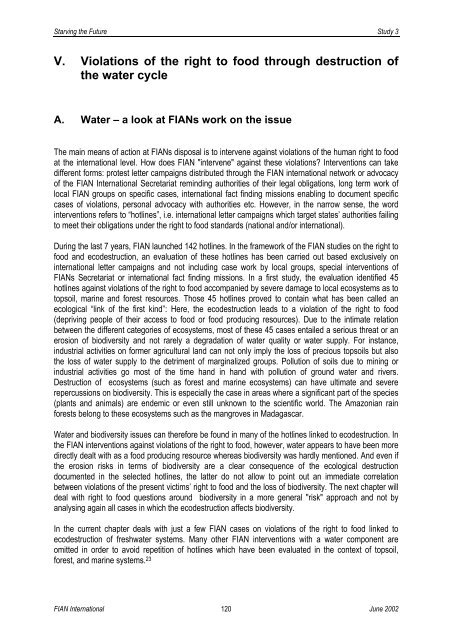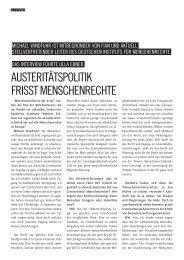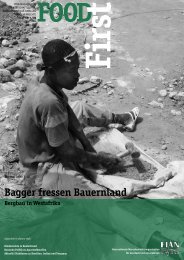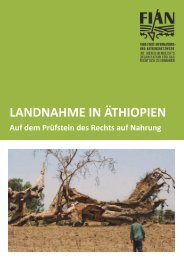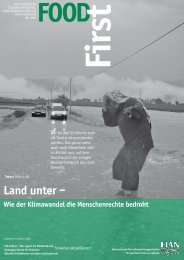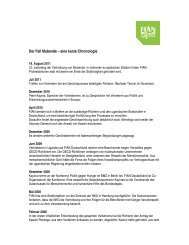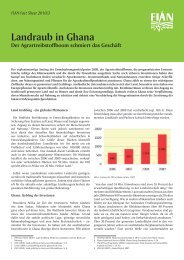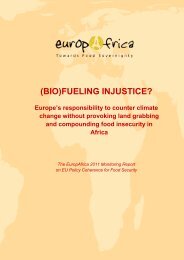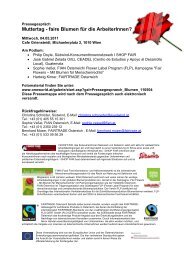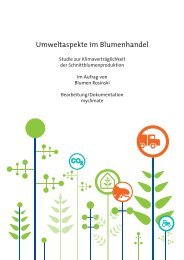Study 3: Ecodestruction and the Right to Food: The Cases of Water ...
Study 3: Ecodestruction and the Right to Food: The Cases of Water ...
Study 3: Ecodestruction and the Right to Food: The Cases of Water ...
Create successful ePaper yourself
Turn your PDF publications into a flip-book with our unique Google optimized e-Paper software.
Starving <strong>the</strong> Future <strong>Study</strong> 3<br />
V. Violations <strong>of</strong> <strong>the</strong> right <strong>to</strong> food through destruction <strong>of</strong><br />
<strong>the</strong> water cycle<br />
A. <strong>Water</strong> – a look at FIANs work on <strong>the</strong> issue<br />
<strong>The</strong> main means <strong>of</strong> action at FIANs disposal is <strong>to</strong> intervene against violations <strong>of</strong> <strong>the</strong> human right <strong>to</strong> food<br />
at <strong>the</strong> international level. How does FIAN "intervene" against <strong>the</strong>se violations? Interventions can take<br />
different forms: protest letter campaigns distributed through <strong>the</strong> FIAN international network or advocacy<br />
<strong>of</strong> <strong>the</strong> FIAN International Secretariat reminding authorities <strong>of</strong> <strong>the</strong>ir legal obligations, long term work <strong>of</strong><br />
local FIAN groups on specific cases, international fact finding missions enabling <strong>to</strong> document specific<br />
cases <strong>of</strong> violations, personal advocacy with authorities etc. However, in <strong>the</strong> narrow sense, <strong>the</strong> word<br />
interventions refers <strong>to</strong> “hotlines”, i.e. international letter campaigns which target states’ authorities failing<br />
<strong>to</strong> meet <strong>the</strong>ir obligations under <strong>the</strong> right <strong>to</strong> food st<strong>and</strong>ards (national <strong>and</strong>/or international).<br />
During <strong>the</strong> last 7 years, FIAN launched 142 hotlines. In <strong>the</strong> framework <strong>of</strong> <strong>the</strong> FIAN studies on <strong>the</strong> right <strong>to</strong><br />
food <strong>and</strong> ecodestruction, an evaluation <strong>of</strong> <strong>the</strong>se hotlines has been carried out based exclusively on<br />
international letter campaigns <strong>and</strong> not including case work by local groups, special interventions <strong>of</strong><br />
FIANs Secretariat or international fact finding missions. In a first study, <strong>the</strong> evaluation identified 45<br />
hotlines against violations <strong>of</strong> <strong>the</strong> right <strong>to</strong> food accompanied by severe damage <strong>to</strong> local ecosystems as <strong>to</strong><br />
<strong>to</strong>psoil, marine <strong>and</strong> forest resources. Those 45 hotlines proved <strong>to</strong> contain what has been called an<br />
ecological “link <strong>of</strong> <strong>the</strong> first kind”: Here, <strong>the</strong> ecodestruction leads <strong>to</strong> a violation <strong>of</strong> <strong>the</strong> right <strong>to</strong> food<br />
(depriving people <strong>of</strong> <strong>the</strong>ir access <strong>to</strong> food or food producing resources). Due <strong>to</strong> <strong>the</strong> intimate relation<br />
between <strong>the</strong> different categories <strong>of</strong> ecosystems, most <strong>of</strong> <strong>the</strong>se 45 cases entailed a serious threat or an<br />
erosion <strong>of</strong> biodiversity <strong>and</strong> not rarely a degradation <strong>of</strong> water quality or water supply. For instance,<br />
industrial activities on former agricultural l<strong>and</strong> can not only imply <strong>the</strong> loss <strong>of</strong> precious <strong>to</strong>psoils but also<br />
<strong>the</strong> loss <strong>of</strong> water supply <strong>to</strong> <strong>the</strong> detriment <strong>of</strong> marginalized groups. Pollution <strong>of</strong> soils due <strong>to</strong> mining or<br />
industrial activities go most <strong>of</strong> <strong>the</strong> time h<strong>and</strong> in h<strong>and</strong> with pollution <strong>of</strong> ground water <strong>and</strong> rivers.<br />
Destruction <strong>of</strong> ecosystems (such as forest <strong>and</strong> marine ecosystems) can have ultimate <strong>and</strong> severe<br />
repercussions on biodiversity. This is especially <strong>the</strong> case in areas where a significant part <strong>of</strong> <strong>the</strong> species<br />
(plants <strong>and</strong> animals) are endemic or even still unknown <strong>to</strong> <strong>the</strong> scientific world. <strong>The</strong> Amazonian rain<br />
forests belong <strong>to</strong> <strong>the</strong>se ecosystems such as <strong>the</strong> mangroves in Madagascar.<br />
<strong>Water</strong> <strong>and</strong> biodiversity issues can <strong>the</strong>refore be found in many <strong>of</strong> <strong>the</strong> hotlines linked <strong>to</strong> ecodestruction. In<br />
<strong>the</strong> FIAN interventions against violations <strong>of</strong> <strong>the</strong> right <strong>to</strong> food, however, water appears <strong>to</strong> have been more<br />
directly dealt with as a food producing resource whereas biodiversity was hardly mentioned. And even if<br />
<strong>the</strong> erosion risks in terms <strong>of</strong> biodiversity are a clear consequence <strong>of</strong> <strong>the</strong> ecological destruction<br />
documented in <strong>the</strong> selected hotlines, <strong>the</strong> latter do not allow <strong>to</strong> point out an immediate correlation<br />
between violations <strong>of</strong> <strong>the</strong> present victims’ right <strong>to</strong> food <strong>and</strong> <strong>the</strong> loss <strong>of</strong> biodiversity. <strong>The</strong> next chapter will<br />
deal with right <strong>to</strong> food questions around biodiversity in a more general "risk" approach <strong>and</strong> not by<br />
analysing again all cases in which <strong>the</strong> ecodestruction affects biodiversity.<br />
In <strong>the</strong> current chapter deals with just a few FIAN cases on violations <strong>of</strong> <strong>the</strong> right <strong>to</strong> food linked <strong>to</strong><br />
ecodestruction <strong>of</strong> freshwater systems. Many o<strong>the</strong>r FIAN interventions with a water component are<br />
omitted in order <strong>to</strong> avoid repetition <strong>of</strong> hotlines which have been evaluated in <strong>the</strong> context <strong>of</strong> <strong>to</strong>psoil,<br />
forest, <strong>and</strong> marine systems. 23<br />
FIAN International 120<br />
June 2002


